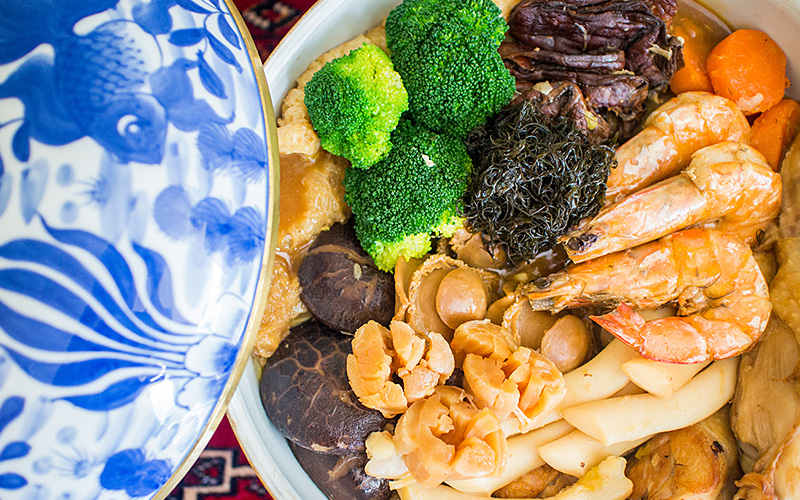
Pen Cai (in Mandarin) or Poon Choi (in Cantonese) is a very traditional dish for the Hakka and Cantonese community. Originating some 800 years ago in the Southern Song Dynasty between A.D. 1132 to 1279, there are two theories as to how this dish was born. One tells the story of the Emperor’s escape to the southern part of China, while in another, scholar-general Wen Tianxiang led his soldiers to Dong Guan (now known as Shenzhen) to escape the Mongol invaders.
Due to its large portion, pen cai is typically made and served during special celebrations like Chinese New Year. As the Cantonese and Hakka migrated away from China, they brought this dish along with them, which is how it spread from Hong Kong to Malaysia and Singapore. To the Hakkas, pen cai was a peasant dish, made with whatever was left in the pantry. However, if you subscribe to the story of the Emperor, the locals collected all their best ingredients and cooked it in one dish to serve him and his army. Regardless of which way this dish was born, the pen cai of modern times involve several fancy dried ingredients.
Pen cai is meant to be expensive, and the price tag increases when you have it at a restaurant for Chinese New Year. Despite its daunting and extensive list of ingredients, pen cai is actually easy to prepare, making this a special dish you can serve at home for Chinese New Year and impress your guests at the same time. It typically includes sea cucumber, smoked duck and roast pork, but this pen cai recipe is a little more accessible so more of us can enjoy this stunning dish. It’s delicious and comforting with an umami sweetness from the dried seafood and mushrooms.
Ingredients
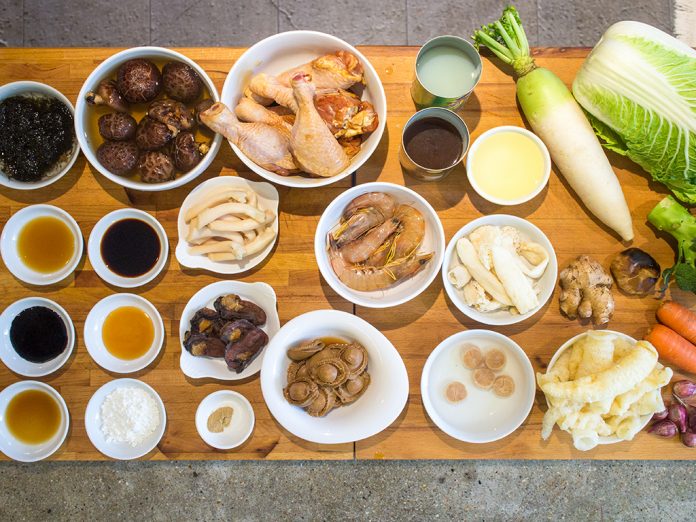
Dried items
- 50g dried fried fish maw
- 45g dried Chinese black mushrooms
- 100g dried bamboo pith
- 10g fat choy
- 35g (5 pcs) dried scallops
- 75g (5 pcs) dried oysters on bamboo stick
Canned items
- 400g (1 can) stewed abalones
- 425g (1 can) sea asparagus
Fresh ingredients
- 6 pcs (750g) (6 pcs) chicken drumsticks
- 130g carrots
- 450g (1 pc) white radish
- 90g shallots
- 60g cloves smoked garlic
- 10g ginger
- 5kg (2 pc) Chinese cabbage
- 300g broccoli
Marinade
- 28g (2 tbsp) dark soy sauce
- 28g (2 tbsp) light soy sauce
- 6g (¼ tsp) white pepper
- 4g (1 tsp) corn starch
Others
- 14g (1 tbsp) sesame oil
- 100ml cooking oil
- 37g (3 tbsp) corn starch
- 5g (1 tsp) dark soy sauce
- 14g (1 tbsp) Shao Xing (Chinese cooking) wine
Fried prawns
- 140g (5 pc) prawns
- 100ml cooking oil
- 6g (¼ tsp) salt
- 6g (¼ tsp) pepper
Instructions
Preparation
- Combine marinade ingredients in a medium bowl and stir mix thoroughly. Fully coat chicken drumsticks with marinade then cover the bowl with cling wrap. Refrigerate for at least two hours. Overnight is better. You can also transfer your chicken and marinade sauces to ziplock bag for refrigerating.
- Soak fish maw in hot water to remove oil residue. Drain and rinse once soft, then keep in a colander placed over a bowl to remove excess liquid.
- Soak Chinese black mushrooms, bamboo pith, fat choy and scallops in individual bowls in regular tap water until soft. For mushrooms, scallops and fat choy, put enough water to just cover each ingredient. Once soft, you can drain the bamboo pith and fat choy liquids, but reserve the liquids from the mushroom and scallops.
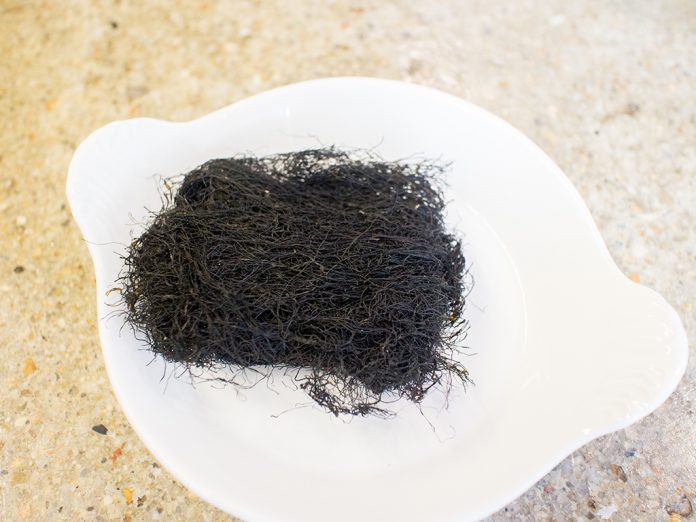
- Remove canned abalone and sea asparagus. Reserve the liquids.
- Lightly smash shallots and garlic with the skin still on. You can use either a mallet or the flat of a knife.
- Slice ginger thinly, leaving the skin on.
- Rinse then peel radish and cut off top and bottom ends. Slice into 1cm round slices.
- Cut off the root ends of the cabbage. Separate each individual leaf and rinse to clean. Drain in a basket or colander.
- Cut broccoli florets. You can also remove the skin on the floret stems.
Frying
- Heat cooking oil in a large wok on high heat.
- Once oil is hot, add dried oysters and fry until fragrant for about 1 and half minutes. This step releases the aroma of the dried oysters into the oil.
- Remove oysters and set aside.
- Add chicken drumsticks to oil and fry to brown the skin. The intention here is not to cook the drumsticks. Turn the drumsticks over so the skin browns evenly. Reserve the leftover marinade.
- Once drumsticks have browned, about 1 and half minutes, remove from the wok and set aside.
- Add smashed shallots, garlic and ginger to the wok, followed by sesame oil. Stir to fry for another 1 to 2 minutes.
- Next, add sliced radish and fry until the surface starts to lightly brown, 1 or 2 minutes. The aunties believe it is important to fry the radish first to counter the ‘cooling effects’ of the root vegetable.
- Add carrots next, followed by the mushrooms. Reserve mushroom liquids. Stir to fry for about 1 and a half minutes.
- Finally, add fried oysters and give everything a quick stir.
Wilting the cabbage
- Arrange cabbage leaves over the ingredients in the wok, covering in thoroughly. There is no need to stir the cabbage… yet. Cover for 5 minutes.
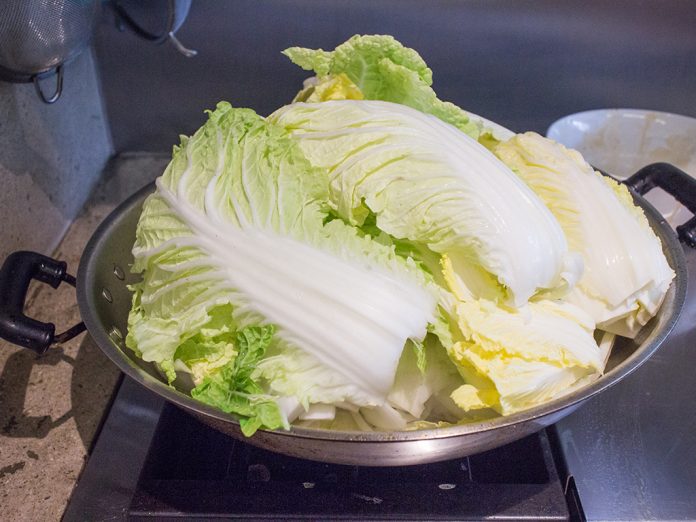
- While waiting, pour sea asparagus and abalone liquids into the reserved chicken marinade. Stir and give it a taste. If you like it, great. After your cabbage has cooked for 5 minutes, pour mixed sauces over the cabbage leaves. If your mixture needs a bit more salt (the flavour may vary based on the brand of canned products used), add a little bit of concentrated chicken stock into the mixture before pouring the sauce all over. Cover your wok again.
- Let your cabbage cook for another 5 minutes or so, checking occasionally. If the bottom layer has wilted significantly more than the top, use a pair of tongs to transfer the lower layers of cabbage to the top.
- Once cabbage has wilted, use a pair of tongs to remove it from the wok into any bowl. You don’t have to remove all the cabbage, but removing as much as you can will help a lot with the next step.
Adding the rest of the ingredients
- Once your wok is mostly clear of cabbage, add drumsticks back to the wok, burying them in the sauce.
- Next, place scallops in the middle of the wok, just on top of the chicken. Reserve the scallop liquids. Once the scallop goes in, don’t stir the dish too often or they may fall apart. If you want the scallops to remain beautiful, you can cook them separately and add it in later. However, this means the flavour won’t be absorbed into the sauce.
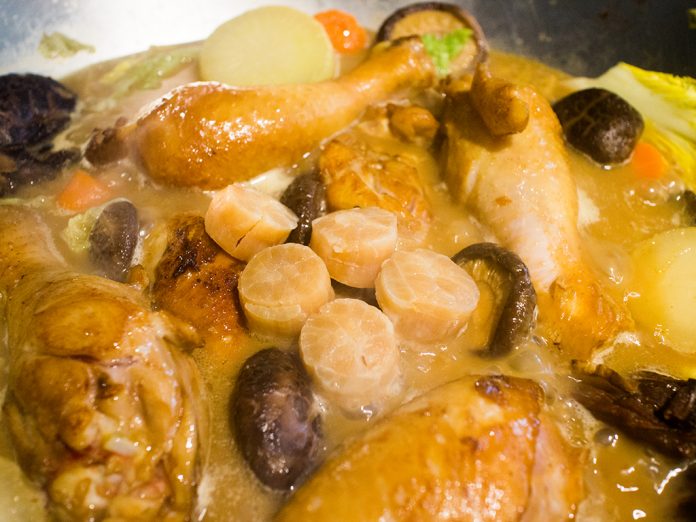
- Transfer the cabbage back into the wok, covering all the ingredients. Don’t forget to pour in any liquids that might have gathered in the bowl of cabbage.
- over and cook for 15 minutes. Don’t stir the dish, but check occasionally by scraping a flat ladle against the bottom of your wok from all sides to ensure nothing gets burned or stuck. If your cabbage hasn’t wilted evenly, scoop up some liquids and pour it over the cabbage. You can also carefully rotate the vegetables if necessary.
- Add fish maw to the side of the wok, pushing it into the sauce and covering it with cabbage.
- Next, add bamboo pith to the wok, also pushing it into the sauce. Cover and let cook for about 8 minutes.
- Finally, arrange broccoli florets over the top of the cabbage so it will steam. Cover and cook for 3 minutes.
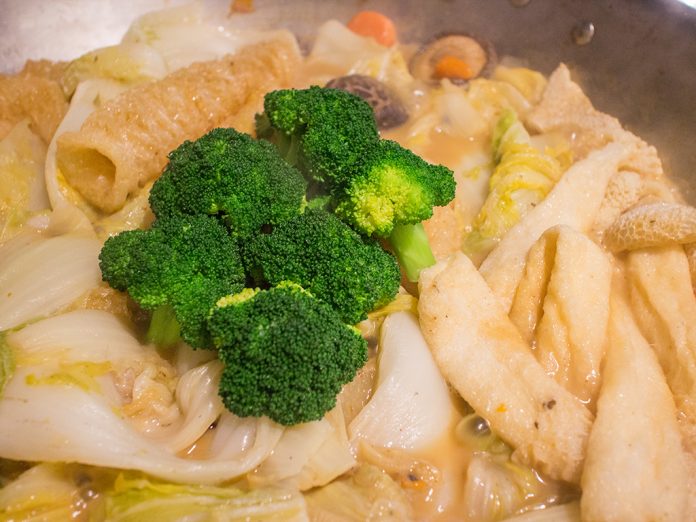
- Remove broccoli then turn the heat off. Also remove bamboo pith and fish maw and set aside.
Pen cai assembly
- Get your biggest bowl and first arrange a thick mound of cabbage inside the bowl.
- Your drumsticks should be cooked by now (check to make sure), so arrange them next, followed by all the other cooked ingredients in the wok, as well as the broccoli, fish maw and bamboo pith. The idea is to arrange all the different ingredients so they can be ‘shown off’. Don’t pour in the liquids yet.
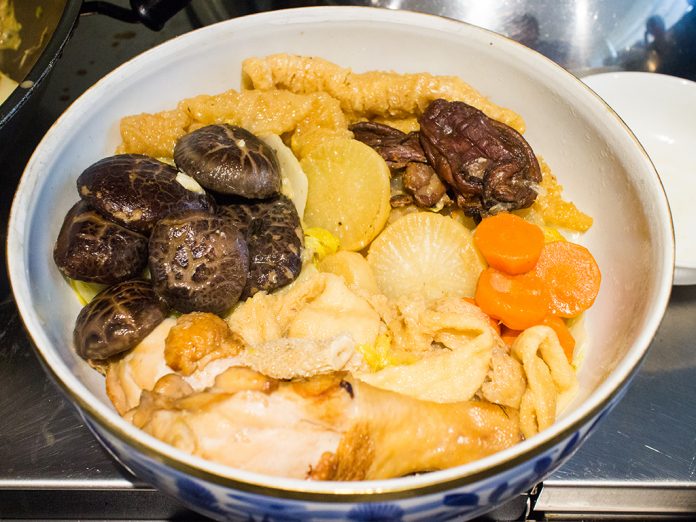
Frying prawns
- In a separate wok, heat sesame oil over high heat for about 1 minute.
- Once the oil is hot enough, add prawns, salt and pepper and quickly flash fry for about 1 minute until prawns cooked.
- Once prawns are cooked, remove from heat and arrange in the bowl.
Final steps
- Once you’ve arranged the ingredients, turn the heat on the wok back on to high. Add sea asparagus and abalone and let it heat up in the wok. Once the liquid starts to simmer, remove both ingredients and arrange in the bowl.
- Finally, arrange soaked fat choy.
- Mix 3 tbsp corn flour with the reserved mushroom and scallop water. Stir to combine.
- Stir 1 tsp dark soy sauce into the mixture. This will darken the sauce. This step is optional if you prefer a lighter toned sauce. It won’t affect the flavour of your pen cai very much.
- Add mixture to the sauce in the wok. Stir to combine.
- Add Shao Xing wine, and bring the sauce to a quick boil. The sauce has a lovely umami sweetness from the flavours of the dried ingredients combined, while the cooking wine adds a lovely depth to the taste of the sauce. It still tastes good without it, so you can opt to leave the wine out if you prefer.
- Carefully pour gravy into the dish, preferably from the sides of the bowl so you don’t spoil your perfectly arranged artwork of ingredients!
- Serve while still hot.
Ingredient tips
- Dried oysters on bamboo sticks are only available during the Chinese New Year season. If you’re making this at any other time of the year, use regular dried oysters.
- The beauty of pen cai is that you don’t have to follow all the dried or even meat ingredients or quantity to a tee. Basically, any dried, expensive and fancy Chinese ingredient will be a welcome addition to this dish. However, if you have no idea how pen cai tastes like or how to make it, we suggest following our recipe first and modifying it to suit your taste buds when you make subsequent servings.
- This dish is traditionally made with roast pork. You can also use smoked duck or kampung chicken, but don’t forget to adjust the cooking time accordingly.
- This dish also traditionally includes sea cucumber. However, it’s an ingredient that requires a lot of preparation. In the interest of simplification, we’ve left it out this time around. If you’re familiar with preparing sea cucumber, go ahead and add it in!
Extra tips
- The earlier part of cooking this dish deals with some very hot oil, so beware as it may pop and fly out of the pan when you cook some of the ingredients.
- How wilted you like cabbage is really up to you. Those with significantly older relatives tend to make them super soft and wilted so it’s easier to chew. If you want your cabbage this way, remove the cooked chicken first and leave the cabbage cooking in the sauce for a few minutes longer.
- Feel free to add more liquid if you’d like more sauce, but do be mindful of the flavour. You may need to add chicken stock if the flavour is not strong enough.
We’d like to thank Jennifer Ker for showing us how to make this delicious pen cai. Will you be making this dish at home for Chinese New Year or that extra special occasion? Don’t forget to tag your pictures with #butterkicap and tell us how you liked it!



